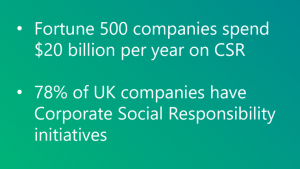How to Build Your CSR Strategy
Business, as we know it, has changed forever. It used to be the case that CSR was a fringe term that only exotic companies cared about. Nowadays, stakeholders – may they be employees, customers, suppliers or even shareholders – expect every single company they interact with to have a fully-formed and live corporate social responsibility – CSR strategy. Are you not sustainable? Then you might find yourself noticing that your market share is on a downward trend and will continue to be so until you change your approach to CSR.

However, developing and executing on a CSR strategy is not as easy as it sounds. If you cannot afford to hire a CSR manager or a consultant, you might find it hard to find the ways in which your company can put doing good in the world at the core of its business strategy.
Where to Start on Your CSR Strategy
We have looked at the trends, studied what both big and small companies are doing, spoken to industry experts, and created this guy to help you make the right choices.
- First, you need to fully understand why your company is doing this. Why are you developing a CSR strategy? Is it to engage with your employees? Is it to create a connection with and help your community? If you’re being honest, is it pressure from your clients or your peers? Whatever the reasons, tailor your approach to them and start from there. Of course, don’t forget to think big. Whatever you think you can achieve, go bigger.
- When you pick your CSR focus, try to consider all sides: from your stakeholders to the way you build or manufacture your products or provide your services. Every step of the way can give you an opportunity to make a difference. When looking to make a decision, you may want to find out what your people care about. You can run a survey and study your internal culture. Review your business model – suppliers, clients, resources you use to do business, and the impact of your products on the environment and your clients. Look at your local community.
- Make sure everyone, especially your management team, buys in. If your colleagues and their managers are not aligned with your CSR strategy and your goals in the space, it will be a constant uphill battle and you will end up wasting time and energy playing a losing game.
Your leaders should… well, lead by example. This involves budgets allocated to CSR initiatives, changing the company’s articles of association and internal policies updates, etc. You should also ensure your marketing and HR departments are aligned with your CSR strategy.

A bit of context
- Put a team in place: depending on your company size, you can have a full-time CSR manager and team or the responsibilities can lie with someone from HR. This is a big internal process – make sure to get some specialised advice on how to implement the necessary changes. Once you put all of this in motion, you should have an efficient tool to manage your strategy and ways to communicate effectively (see below).
- Once you have everyone on board, make sure you communicate well with them and make them understand what you are trying to achieve, as well as the avenues you are looking to take in order to get there. Once they understand the goals and the roles they can play, it will be smooth sailing when trying to get their support.
In order to reap the benefits of your CSR strategy, it needs to be communicated effectively both internally and externally. Make sure you have the tools to engage internal staff with every CSR initiative, give everyone a voice and a chance to participate, track and measure what employees are interested in and engage mostly with. Lastly, remember that your customers want to connect with your company over the good things you are doing – no need for big PR campaigns – constant outgoing communication with short messages demonstrating what you stand for is enough. Naturally, use social media and other digital outlets such as your own website to spread the word.
- Make sure your strategy is always up to date and you are considering the changes in trends, context, and business goals. That way, you can adapt as you go.
- Keep a track record of your CSR initiatives. That is useful not only internally, but companies now often ask for such documents in their procurement process and will choose your products over those of others if your company is more sustainable than your competitors. In the case of public contracts, this is actually mandated by law.
Conclusion
Whatever you choose to do, make sure your CSR strategy fully aligns with your business strategy and your company ethos. That way, your CSR initiatives will speak for you and your stakeholders will always know what your company and your colleagues stand for when it comes to doing good in the world.
(KindLink is the technology platform supporting corporates in managing their CSR, offering features ranging from CSR strategy development and impact reporting to measuring SDGs, employee engagement and volunteering opportunities marketplace)
Please follow and like us:
Share this:
How to Build Your CSR Strategy
Business, as we know it, has changed forever. It used to be the case that CSR was a fringe term that only exotic companies cared about. Nowadays, stakeholders – may they be employees, customers, suppliers or even shareholders – expect every single company they interact with to have a fully-formed and live corporate social responsibility – CSR strategy. Are you not sustainable? Then you might find yourself noticing that your market share is on a downward trend and will continue to be so until you change your approach to CSR.
However, developing and executing on a CSR strategy is not as easy as it sounds. If you cannot afford to hire a CSR manager or a consultant, you might find it hard to find the ways in which your company can put doing good in the world at the core of its business strategy.
Where to Start on Your CSR Strategy
We have looked at the trends, studied what both big and small companies are doing, spoken to industry experts, and created this guy to help you make the right choices.
Your leaders should… well, lead by example. This involves budgets allocated to CSR initiatives, changing the company’s articles of association and internal policies updates, etc. You should also ensure your marketing and HR departments are aligned with your CSR strategy.
A bit of context
In order to reap the benefits of your CSR strategy, it needs to be communicated effectively both internally and externally. Make sure you have the tools to engage internal staff with every CSR initiative, give everyone a voice and a chance to participate, track and measure what employees are interested in and engage mostly with. Lastly, remember that your customers want to connect with your company over the good things you are doing – no need for big PR campaigns – constant outgoing communication with short messages demonstrating what you stand for is enough. Naturally, use social media and other digital outlets such as your own website to spread the word.
Conclusion
Whatever you choose to do, make sure your CSR strategy fully aligns with your business strategy and your company ethos. That way, your CSR initiatives will speak for you and your stakeholders will always know what your company and your colleagues stand for when it comes to doing good in the world.
(KindLink is the technology platform supporting corporates in managing their CSR, offering features ranging from CSR strategy development and impact reporting to measuring SDGs, employee engagement and volunteering opportunities marketplace)
Post-Polio Syndrome: Why It's...
How to Choose Your Volunteering Pl...
KindLink Global Team
contact@kindlink.global
Support and care for asylum se...
Building confidence in young p...
Saving the environment through...